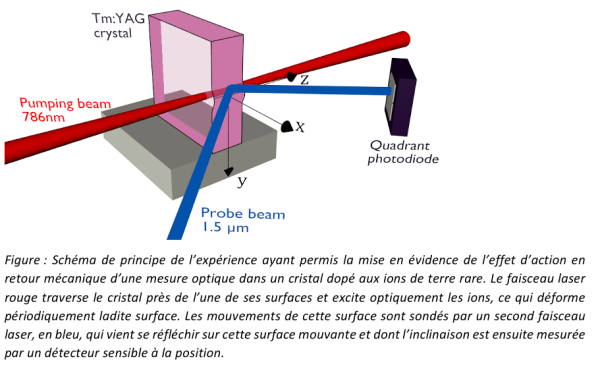The interaction of light with matter lies at the heart of quantum technologies: the high selectivity of laser light allows for precise control of the quantum state of atoms. This principle underlies the use of rare-earth-ion-doped crystals, in which atomic impurities benefit from structures that ensure the protection of their quantum properties. These materials are currently experiencing remarkable growth with numerous applications such as high-speed information processing, quantum memories and converters, and metrology.
The utilization and performance of these systems are limited by the very action of optical measurement, which can lead to significant distortions of the spectrum of atoms illuminated by the laser beam. The origin of this long-known phenomenon remained an open question, primarily due to the multiplicity of mechanisms that could be involved. This important question is addressed by the work of researchers from the Langevin Institute, LuMIn, and the Neel Institute, identifying the fundamental process underlying these disturbances [2].
To understand this, it is necessary to take a step back: in quantum mechanics, the concept of measurement is inseparable from that of feedback, which corresponds to a dynamic effect altering the state of the measured observable. These concepts are related to Heisenberg’s Uncertainty Principle, which states that the precision of measuring a physical quantity cannot be indefinitely increased without sacrificing another variable of the system (such as the position and velocity of a moving particle, respectively).
In previous work on a specific crystal, Tm:YAG, researchers noticed that continuous measurement of the state of atoms represented an extremely sensitive estimate of the locally applied constraints on the crystal [1]. Following the fundamental principles of quantum mechanics, such a measurement should necessarily be accompanied by a feedback effect, meaning the appearance of a constraint in the vicinity of the illuminated atoms. This hypothesis was very audacious: the evaluation of such an effect, never observed before, yielded very low values that would make its observation illusory, if not impossible.
The researchers then devised a clever experiment to map the temporal evolution of deformations in a Tm:YAG crystal subjected to periodic excitation of atoms near its surface. This novel "time-resolved optomechanical tomography" device allows decoupling of the different forcing phenomena involved according to their own dynamics. Thus, the researchers were able to directly demonstrate the force associated with the resonant illumination of atoms and identify its two main components: a photothermal stress on the one hand, resulting from the non-radiative de-excitation of atoms, and a stress associated with the change in the atom’s orbital state, called "piezo-orbital," corresponding to the desired effect.
One of the most remarkable aspects of this demonstration is the nearly perfect match between the internal dynamics of atoms and the macroscopic forces generated by their illumination, establishing a direct link between the quantum and classical worlds. This link is even more surprising as these experiments were all conducted under ambient temperature and pressure conditions, opening up new and interesting possibilities, particularly for quantum technologies. This work also highlights the potential of rare-earth-ion-doped crystals as a new ultra-sensitive "hybrid optomechanical system," with the prospect of reversible transfer of quantum states to mechanical states.
Phys. Rev. Applied 20, 054004 (2023)
DOI: https://doi.org/10.1103/PhysRevApplied.20.054004

[1] Louchet-Chauvet, A., Ahlefeldt, R., & Chanelière, T. (2019). Piezospectroscopic measurement of high-frequency vibrations in a pulse-tube cryostat. Review of Scientific Instruments, 90(3). https://doi.org/10.1063/1.5080086
[2] A. Louchet-Chauvet, P. Verlot, J.-P. Poizat, T. Chanelière, Piezo-orbital back-action force in rare-earth doped crystals, Physical Review Applied, 20, 054004 (2023) https://doi.org/10.1103/PhysRevApplied.20.054004
[Contact:
Anne Louchet-Chauvet, CNRS researcher; Institut Langevin, ESPCI Paris, CNRS, PSL University - anne.louchet-chauvet@espci.fr]







